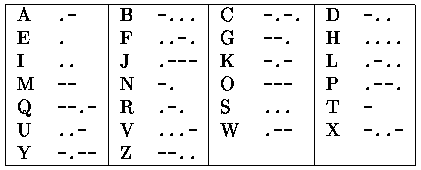当前你的浏览器版本过低,网站已在兼容模式下运行,兼容模式仅提供最小功能支持,网站样式可能显示不正常。
请尽快升级浏览器以体验网站在线编辑、在线运行等功能。
1432:Decoding Morse Sequences
题目描述
Before the digital age, the most common "binary" code for radio communication was the Morse code. In Morse code, symbols are encoded as sequences of short and long pulses (called dots and dashes respectively). The following table reproduces the Morse code for the alphabet, where dots and dashes are represented as ASCII characters "." and "-":

Notice that in the absence of pauses between letters there might be multiple interpretations of a Morse sequence. For example, the sequence -.-..-- could be decoded both as CAT or NXT (among others). A human Morse operator would use other context information (such as a language dictionary) to decide the appropriate decoding. But even provided with such dictionary one can obtain multiple phrases from a single Morse sequence.
Task
Write a program which for each data set:
reads a Morse sequence and a list of words (a dictionary),
computes the number of distinct phrases that can be obtained from the given Morse sequence using words from the dictionary,
writes the result.
Notice that we are interested in full matches, i.e. the complete Morse sequence must be matched to words in the dictionary.

Notice that in the absence of pauses between letters there might be multiple interpretations of a Morse sequence. For example, the sequence -.-..-- could be decoded both as CAT or NXT (among others). A human Morse operator would use other context information (such as a language dictionary) to decide the appropriate decoding. But even provided with such dictionary one can obtain multiple phrases from a single Morse sequence.
Task
Write a program which for each data set:
reads a Morse sequence and a list of words (a dictionary),
computes the number of distinct phrases that can be obtained from the given Morse sequence using words from the dictionary,
writes the result.
Notice that we are interested in full matches, i.e. the complete Morse sequence must be matched to words in the dictionary.
输入解释
The first line of the input contains exactly one positive integer d equal to the number of data sets, 1 <= d <= 20. The data sets follow.
The first line of each data set contains a Morse sequence - a nonempty sequence of at most 10 000 characters "." and "-" with no spaces in between.
The second line contains exactly one integer n, 1 <= n <= 10 000, equal to the number of words in a dictionary. Each of the following n lines contains one dictionary word - a nonempty sequence of at most 20 capital letters from "A" to "Z". No word occurs in the dictionary more than once.
The first line of each data set contains a Morse sequence - a nonempty sequence of at most 10 000 characters "." and "-" with no spaces in between.
The second line contains exactly one integer n, 1 <= n <= 10 000, equal to the number of words in a dictionary. Each of the following n lines contains one dictionary word - a nonempty sequence of at most 20 capital letters from "A" to "Z". No word occurs in the dictionary more than once.
输出解释
The output should consist of exactly d lines, one line for each data set. Line i should contain one integer equal to the number of distinct phrases into which the Morse sequence from the i-th data set can be parsed. You may assume that this number is at most 2 * 10^9 for every single data set.
输入样例
1 .---.--.-.-.-.---...-.---. 6 AT TACK TICK ATTACK DAWN DUSK
输出样例
2
最后修改于 2020-10-29T06:04:02+00:00 由爬虫自动更新
共提交 0 次
通过率 --%
| 时间上限 | 内存上限 |
| 3000 | 65536 |
登陆或注册以提交代码